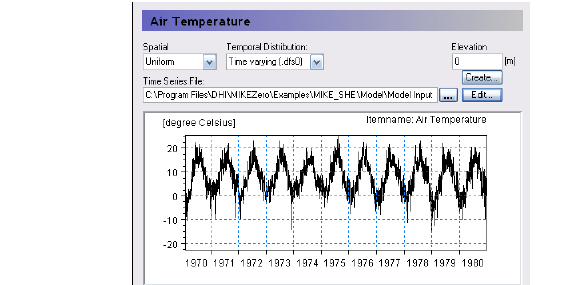

|
Air Temperature |
|
|---|---|
|
Conditions |
if Snow melt selected, or if Temperature Dependent Decay is selected |
|
dialogue Type |
|
|
Grid Code |
|
|
Time Series EUM Data Units |
Temperature; Instantaneous |
Elevation - This is the station elevation. It is used as the reference elevation if the cell-by-cell temperatures are to be corrected for elevation differences (See Elevation corrections (V1 p. 229)). The elevation correction is specified by the Temperature Lapse Rate (V1 p. 237), or optionally by the Wet Lapse Rate (V1 p. 238) if it is raining. Elevation correction is not available for fully distributed temperature data.
Snowmelt - This is the temperature in Celsius that is used to calculate snow melt and accumulation:
· If the Air temperature is below the Threshold Melting Temperature (V1 p. 240) value, then the precipitation accumulates as snow; above it is treated as rain.
· If the Air temperature is above the Threshold Melting Temperature (V1 p. 240) value, then dry snow is converted to wet snow using the Degree-day Melting or Freezing Coefficient (V1 p. 241).
· If the Air temperature is below the Threshold Melting Temperature (V1 p. 240) value, then wet snow is converted to dry snow using the Degree-day Melting or Freezing Coefficient (V1 p. 241).
Temperature Dependent Decay - This is the air temperature used for calculating the soil temperature for temperature dependent decay in the water quality module.
Related Items
· Creating Time Series in MIKE SHE (V1 p. 145)
· Working with Spatial Time Series (V1 p. 147)
· Time Series Types (V1 p. 147)
· Threshold Melting Temperature (V1 p. 240)
· Degree-day Melting or Freezing Coefficient (V1 p. 241)
· Snow Melt - Technical Reference (V1 p. 449)
· Working with Freezing and Melting - User Guide (V1 p. 455)